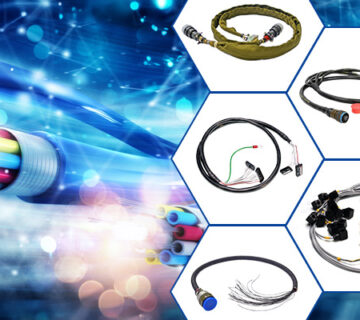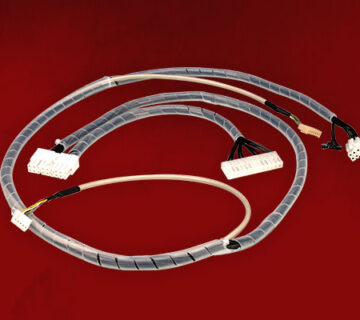Wire harnesses serve as essential conduits for electrical signals that connect and power various components of automobiles. These harnesses may look simple, but they are made of a complex mix of materials that have been carefully chosen to guarantee longevity, dependability, and superior performance. The selection of materials for the conductors, insulation, jacketing, and shielding of the harnesses is critical in determining its resistance to severe automotive conditions, including high/low temperatures, moisture, vibration, and chemical exposure. To design harnesses that satisfy strict safety and performance requirements, engineers must strike a balance between these variables, while also considering the weight, cost, and manufacturability. The intricate design and material composition of wire harnesses continue to be fundamental to vehicle innovation and functionality in the ever-changing automotive industry. Let’s take a tour around the world of wire harness materials, looking at what goes into choosing them and how important they are to improving the durability and effectiveness of automobile electrical systems.
Understanding the role of wire harness materials
By transferring electrical signals between sensors, actuators, control modules, and other electronic components, wire harnesses serve as the nervous system of vehicles. The performance qualities of the harness, such as electrical conductivity, mechanical strength, thermal resistance, and environmental endurance, are largely determined by the materials used in its construction. The capacity of the materials used for wire harnesses to endure the challenging working conditions seen in automotive settings is one of the main factors to be taken into account. Extremes in temperature, moisture exposure, vibration, abrasion, and chemical pollutants are just a few of the challenges that need to be overcome with proper material selection and design.
Factors influencing material selection
Selecting the right materials for automotive wire harnesses is a difficult choice affected by several important variables. To guarantee that the harnesses satisfy the strict specifications of contemporary automobiles, engineers must carefully take into account a number of factors. Manufacturability, cost considerations, performance requirements, and regulatory compliance are all important aspects that are taken into account throughout this decision-making process. In order to maximize the value, dependability, and efficiency of the wire harness, and eventually improve the overall functioning and safety of automotive systems, each component must be balanced well.
- Performance requirements: The operational environment and intended application determine which wire harness material performance attributes are necessary. Materials with corresponding heat resistance, chemical compatibility, and mechanical strength are required for high-temperature situations, exposure to chemicals or fluids, and mechanical stresses.
- Regulatory compliance: Strict safety and legal requirements, including those imposed by groups like the SAE and ISO must be met by automotive wire harnesses. To guarantee the lifespan, dependability, and conformity of the product with industry rules, the selection of materials must be in line with these requirements.
- Cost considerations: Cost factors are important when choosing a material, even though performance and dependability come first. To maximize the value proposition of wire harnesses, engineers must balance material quality, performance characteristics, and total production costs.
- Manufacturability: Material selection is influenced by wire harness manufacturability, which includes aspects like processing simplicity, automation compatibility, and mass production adaptability. Preferred options are materials that support effective production procedures while preserving uniformity and quality.
Common wire harness materials
For optimum performance and longevity, wire harnesses require a range of carefully chosen materials. Wire harnesses can resist the harsh circumstances of automotive applications because of the special qualities of the chose materials. Engineers may design wire harnesses that offer dependable and effective performance, guaranteeing smooth communication and protection for automotive components, by utilizing an appropriate combination of materials.
- Conductors: Copper’s superior electrical conductivity and malleability make it the material of choice for wire conductors. But, because of the developments in metallurgy, aluminium conductors and copper alloys with high conductivity have been created, providing less weight and improved performance.
- Insulation materials: Insulation materials enclose conductors to provide protection from mechanical damage, moisture intrusion, and electrical shorts. PVC, XLPE, TPE, and PTFE are examples of common insulating materials. Because every material has distinct qualities such as flexibility, resilience to temperature changes, and chemical compatibility, engineers may customize insulation choices to meet the demands of particular applications.
- Jacketing materials: Jacketing materials give wire harnesses further defence against environmental factors and mechanical strain. PVC, TPU, and TPE are examples of thermoplastic materials that are widely used due to their flexibility, resilience to abrasion, and simplicity of processing. However, in demanding applications, thermoset materials, such as silicone rubber and fluoropolymers, provide better temperature resistance and environmental resilience.
- Shielding materials: To encapsulate wire bundles and stop signal deterioration in situations where electromagnetic interference (EMI) must be reduced, shielding materials including copper braid, aluminium foil, and conductive polymers are used. A vehicle’s space limitations, attenuation needs, and EMI frequency range all influence the choice of shielding material.
The choice of wire harness materials is a crucial one in the intricate field of automobile engineering as it has an immediate effect on the functionality, robustness, and dependability of automotive electrical systems. Car engineers can optimize wire harness designs for the many challenges of contemporary automotives by having a thorough awareness of the special qualities and factors related to conductors, insulation materials, jacketing materials, and shielding materials. Wire harnesses may continue to function as dependable electrical connectivity conduits, enabling the development of automotive technology and improving the driving experience for customers, with careful material selection and thorough testing. Miracle Electronics, with the largest wiring harness manufacturing in India, is essential to this procedure as they deliver high-calibre, professionally crafted wire harnesses that satisfy the exacting requirements of the automotive industry.




